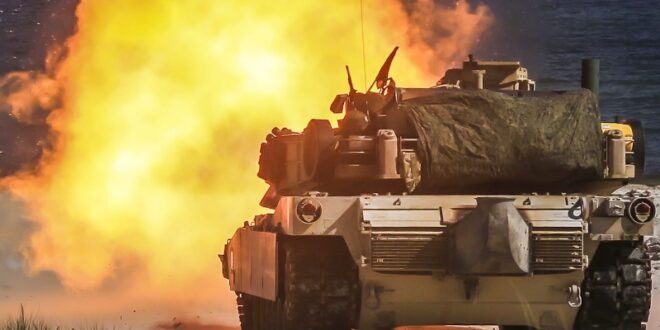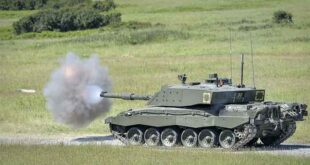Poland has declared its ambition to become the strongest military power in Central Europe. A NATO spending-leader already, Warsaw is eying a two-fold expansion of its armed forces, even though this will entail huge costs and defy demographic trends. Can it succeed?
Tons of heavy armour will soon be rolling off the transport ships and rail ramps across Poland this year. The mighty M1A2 Abrams tanks have been regular visitors here since 2017, when the US armoured brigade was the first sent to reinforce NATO’s eastern flank in response to Russia’s first offensive against Ukraine.
But now, at another time of Russian aggression against Ukraine, these tanks will belong to the Polish Armed Forces rather than the US Army, and they will be sent to a different place – to the lowland plains east of Warsaw, a traditional place for major battles with Russia.
The arrival of the heaviest military equipment in the West will herald the Polish government’s pledge from July 2021 to “radically increase” the country’s defence capabilities and to expand the Polish Armed Forces to a staggering 300,000 personnel – a combination of the regular professional army and part-time volunteer Territorial Defence Force, which was created in 2017.
Given that the current numbers are, respectively, 113,000 regular active service men and women and 32,000 TDF, this would entail a doubling of the army’s size. According to experts, that’s a tall order which may never ultimately be delivered.
Braced for war
The sense of heightened alert in Poland has been amplified by several events over the past year.
First, there were the images of thousands of migrants storming Poland’s eastern border, part of a “hybrid war” conducted by Belarusian President Aleksandr Lukashenko. In the summer of 2021, the autocrat began creating this new migratory route by tempting migrants from the Middle East and Africa to Minsk, then herding them across the border in retaliation for EU sanctions imposed after Belarus’s rigged 2020 presidential election, as well as to help serve Russian President Vladimir Putin’s goal of destabilising NATO and the EU, security experts say.
Fears of a new Russian attack on Ukraine are also playing a role. Towards the end of 2021, Russia began amassing 100,000 or more troops plus tanks and other heavy weaponry on the Ukrainian border with Russia and Belarus, on the back of unsubstantiated claims by the Kremlin that Ukraine and the Western powers, including the US, were planning some kind of “provocation”. Experts believe, rather, it is an attempt by Russia to wring concessions out of NATO about preventing Ukraine and Georgia from joining the military alliance.
For supporters of Poland’s ruling Law and Justice (PiS), all this was enough to justify the party’s leader, Jaroslaw Kaczynski, in declaring nothing less than a state of emergency in national defence.
“The security conditions have deteriorated so much that Poland, as a frontline state, has no choice but to radically re-arm itself and become one of the best European armies, in order to sustain itself alone under Russian attack, for a longer period, until NATO comes to help Poland,” Kaczynski claimed in October 2021, when announcing a new draft bill related to military expansion.
A command exercise staged a year ago demonstrated that current military levels were insufficient to achieve that, with the Polish Armed Forces allegedly defeated in a table-top war game. Hence Kaczynski’s push to expand and upgrade.
Key to this is the increase in defence spending to 2.5% of GDP by 2026, and an extra funding scheme which includes bonds, loans and leasing options. While details of the latter need to be worked out, the PiS-led cabinet prides itself on being among NATO’s top spenders (2.2% of GDP in 2022).
This year’s military spending stands at 57.7 billion zlotys, or 12.5 billion euros, which will consume 12 per cent of the country’s budget. By comparison, Poland’s underfunded public health system receives about twice as much, leaving many to wonder how much an army double the size would cost taxpayers and how it could be funded.
Yet for this government, money does not seem to be a problem. Even in the midst of the COVID-19 pandemic, the Polish economy has kept on delivering outstanding growth and tax hikes implemented under the PiS’s flagship “Polish Deal” policy – a package of measures aimed at benefitting the neediest in society ahead of the 2023 election. This suggests a government confident of revenue projections as well as its borrowing power.
Despite the rising debt levels, both in government accounts and hidden in non-budgetary funds, which have mushroomed during PiS’s time in office, Polish leaders continue to tell the nation that security has no price and the country must spend whatever is needed.
According to the Defence Ministry, the military modernisation plan until 2035 has a price tag of 524 billion zlotys (115 billion euros), but details have not been made public. The increased spending also does not require parliamentary approval, let alone a referendum, even for the largest procurement items. Just the signature of Defence Minister Mariusz Blaszczak, one of Kaczynski’s righthand men, will suffice.
Made in the U.S.A.
And judging from his time in office, Blaszczak certainly likes putting his name on the dotted line, especially for products that have been “made in the USA”. Patriot air and missile defence systems, F-35 stealth fighters, HIMARS rocket launchers, Black Hawk helicopters (made in Poland by Lockheed Martin) and even used MRAP vehicles from Afghanistan are just some of the military contracts running into billions of dollars that he has signed since becoming defence minister in 2018.
The previously mentioned Abrams tank procurement, due to arrive in a few months’ time, will be the most substantial so far at a cost of 23 billion zlotys (5 billion euros). In an effort to make the Polish army great again, Blaszczak is clearly making it overwhelmingly technologically dependent on Washington, since the deals rarely stipulate offset arrangements that would benefit local producers.
Yet even with these huge deals in the pipeline, the Polish Armed Forces are far from modern. Neglected for 20-plus years, they still use equipment originating from Cold War times.
Tomasz Dmitruk, an analyst at the New Military Technology monthly, recently published data that shows the vast majority of Poland’s tanks, fighting vehicles, helicopters and navy vessels have not been replaced or upgraded for some 30 to 40 years. Some “specimens” would even qualify as items of national heritage, being 50 years old and up.
According to Dmitruk, even with the increased spending it will take at least another decade, if not two, to replace and upgrade the existing equipment to modern standards. “An expansion of the army in numbers will impede the pace of modernisation, which is already sluggish, and will move it beyond any realistic timeframe,” he tells BIRN.
But even if costly and difficult to maintain, experts say the gear is the easier part of Poland’s defence vision. The principal problem, they say, is the vision itself.
The numbers don’t add up
The last time Poland had an army of such size was when the country was part of the Warsaw Pact (1955-1989) and existed to reinforce the Red Army. But even though the Polish Army was the second largest in the Communist Bloc, it wasn’t designed by the Poles and did not serve their interests.
The newly democratic Poland that emerged from communism in 1991 had neither the money nor the strategy to maintain the upkeep of a few hundred thousand conscripts. It thought that the bonds with the West would provide security and Russia’s relative weakness didn’t require a huge army either. During its time in NATO since 1999, Poland has spent a lot on “out of area” requirements. Poland maintained a substantial presence in both Afghanistan and Iraq during the NATO-led and US-led operations there, which cost the Defence Ministry 6,5 billion zlotys, according to the Operations Command.
When Putin’s revanchist agenda became clear during the 2008 war in Georgia, it took years before Poland’s government under Donald Tusk‘s Civic Platform (2007-2015) forged an ambitious modernisation plan. Even then, it did not halt the reduction of personnel below 100,000 – a significant size for Europe’s average, but no match for the Russians.
The core of the plan was to invest in new technology, not large numbers: long-range precision weapons, layered air defence, drones of all sorts, sensors and NATO-integrated datalinks. PiS criticised the structural changes as “disarming Poland” and since returning to power in 2015 has set the expansion of the armed force numbers as its goal.
Yet after seven years in power, and despite intensive recruitment efforts and hiking military wages above the average, the government has only managed to raise the numbers of the professional army by 13 per cent. And at 32,000, the volunteer TDF stands well below its intended size of 50,000.
The goal of a total 300,000-strong fighting force seems as distant today as it has ever been. And it is becoming much more difficult to reach in the future.
Even without the COVID-19 hit on the population, which has taken its toll on the elderly and middle-aged, Poland’s population is shrinking precipitously. While there’s more than 3 million men between the ages of 35 and 45, that number drops significantly in younger generations. Even if all of today’s 18-year-old males joined a “grand army”, they would fill less than two-thirds of it. At the same time, there is an all-time low in new births, offering little hope for recruits in 20 years’ time.
As the Chief of General Staff, General Rajmund Andrzejczak, put it in a lecture he gave in November: “There simply may not be that many [Polish] warriors.”
Given this, Andrzejczak spoke about the need for more automation and put robots in the field. He was absent when Blaszczak and Kaczynski launched their ‘grand vision’ for the armed forces in October 2021 and he has never offered a word of support since.
Andrzejczak’s predecessor, General (ret.) Mieczysław Gocul, put it more bluntly in an interview: “Poland cannot afford a 300,000 army of mediocre quality, poor training and technological backwardness.”
Yet some officers in active service have been more enthusiastic. The chief of the TDF, Lieutenant General Wieslaw Kukula, told Dziennik Gazeta Prawna in November that, “a society that entrusts its defence to a small army makes itself a target”. Under PiS, Kukula has enjoyed promotion from a rank of colonel to a three-star general and remains one of the key people around the defence minister.
The question for many observers is whether PiS’s great announcement made in 2021 is really a concrete plan or just a vision that plays well amongst voters.
The Defence Ministry so far has offered no timeline, no funding plan has been elaborated or is in place, and no structure has been provided to the goal. This doesn’t mean PiS doesn’t have it; observers point out it is official ministry policy not to disclose too many numbers.
However, even in the diminished democracy that Poland has become since PiS took power in 2015, critics argue a two-fold expansion of the armed forces should be debated and decided upon beyond the government, simply because such a policy needs much more than a parliamentary term to happen and will bring consequences for all aspects of Polish socioeconomic life.
 Eurasia Press & News
Eurasia Press & News




